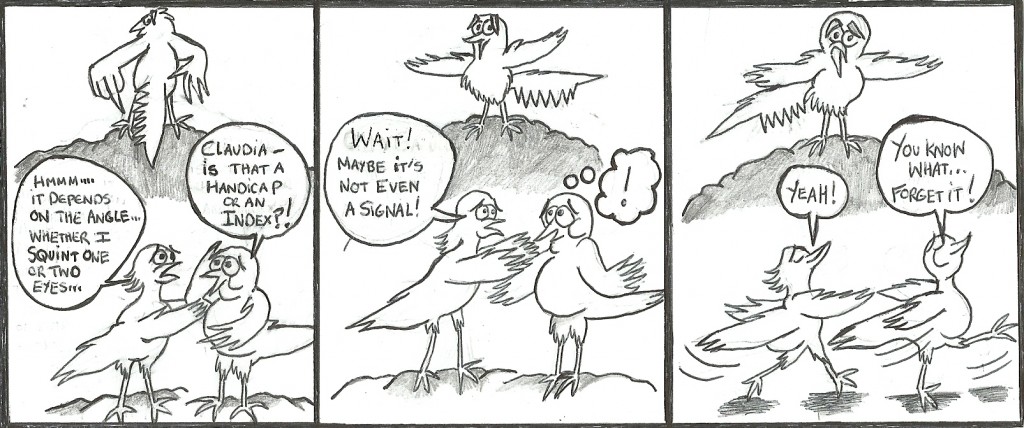The differences between handicaps and indices are usually distinguishable in formal mathematical models or in unambiguous real-world cases. Often though, classifying a trait as a handicap, an index, or even a signal at all, can be quite a difficult task.
For the purposes of illustration I will use Fluctuating Asymmetry (FA for short) as an example. Fluctuating asymmetry is the term used to refer to deviation from symmetry in paired morphological structures (ranging from birds’ tails to human faces) that should be, all being well, bilaterally symmetric. Deviations from the ideal symmetrical phenotype are caused by inherent genetic perturbations and exposure to environmental disturbances occurring in early development.
Is FA a signal?
In their 2005 book Animal Signals, Maynard-Smith and Harper define a signal as:
‘Any act or structure which alters the behaviour of other organisms, which evolved because of that effect, and which is effective because the receiver’s response has also evolved’
They then argue that FA is unlikely to function as a signal because it is difficult to discern whether receivers respond directly to FA and because there appear to be few examples of displays in which signallers actively advertise their symmetry to receivers.
Has receiver response evolved?
The females of a range of species seem to prefer to mate with more symmetrical males which seems to indicate that FA indeed influences or alters their behaviour. But importantly as Maynard Smith and Harper point out, it is not always clear whether females are responding directly to symmetry in making such choices. Instead, it seems that in some cases it is more likely that symmetry covaries with other markers that females use in mate choice (e.g. see Scheib et al’s 1999 study of human face preferences).
It follows that if high levels of symmetry functions as a signal that influences the mating decisions of females and females pay attention to this, then males should directly advertise this signal to females. There is little experimental evidence to demonstrate this, but Zahavi (1993) suggested that decorative patterns may help a receiver to evaluate symmetry. The problem however, is that such asymmetries are very subtle, especially in complex patterns. Studies of asymmetry detection in European starlings (e.g. Johnson et al. 2008) for example, suggest that this species can detect asymmetry to some degree but that this ability is limited with regards to the plumages of conspecifics.
Why has the receiver response evolved?
Although it seems unlikely that a direct female preference for symmetrical males is a species-wide phenomenon, it has not prevented the following question from being asked: Why might female preferences for symmetry have evolved?
The dominant hypothesis, especially in evolutionary psychology, is that FA is an honest indicator of genetic quality and heritable fitness and that it is used in viability-based sexual selection, both in intrasexual competition and mate choice. Results pointing to heritability of FA , a relationship between symmetry and other measurements of quality, and a mating advantage for males with low FA, suggests that there may be a link in some species.
Alternatively, Enquist and Arak (1994) raise the possibility that preferences for symmetry may have arisen as a by-product of the need to recognise objects, including mates, at any position and orientation in the visual field. These scholars argue that in humans and other species, an attraction to symmetry extends beyond contexts that are related to signalling, such as symmetry in decorative art.
However, both hypotheses are troubled by the fact that evidence to suggest direct female mating preferences for FA is currently scarce and inconclusive.
Is FA a handicap or an index?
If it is true that the females of some species choose mates on the basis of FA because it is a reliable indicator of developmental stability and ‘good genes’, should FA be considered a handicap or an index?
In his 1993 paper, Amotz Zahavi argues that FA is a condition-dependent handicap. According to him, the development of an ornament with low FA is more costly than that of an ornament with high FA. He suggests that this is because a high amount of investment is required to maintain reliable communication between cells that regulate the development of each side of the body, a process which is less costly for high quality than low quality individuals, particularly under stressful conditions.
On the other hand, the index argument for FA follows that due to the absence of empirical evidence for the existence of such a cost it is more appropriate to think of FA as an inescapable signal of upbringing and genetic integrity that males signal without cost. FA is thus an index of environmental stability and/or genetic quality in that females are able to discriminate males on the basis of stress levels they have been exposed to and how well their genotypes have fared in response.
References
Enquist, M and Arak, A. (1994) Symmetry, beauty and evolution. Nature. Vol.327, 169-172.
Maynard Smith, J. and Harper, D. G. C. (1995) Animal Signals: Models and Terminology. Journal of Theoretical Biology 177, 305-311.
Scheib, J. E, Gangestad, S. W. and Thornhill, R. (1999) Facial attractiveness, symmetry and cues of good genes. Proc. R. Soc. Lond. Vol.266, 1913-1917.
Swaddle, J. P. et al. (2008) A test of receiver perceptual performance: European starlings’ ability to detect asymmetry in a naturalistic trait. Animal Behaviour 76:2, 487-495
Zahavi, A. (1993) The Fallacy of Conventional Signalling. Phil. Trans. Soc. Lond. B. 340: 1292, 227-230.


Is there even a principled way for operationalising this distinction?